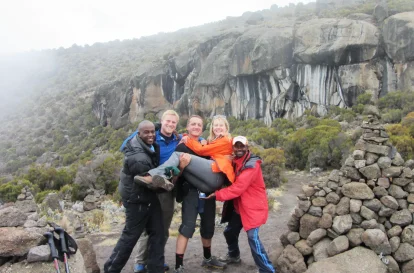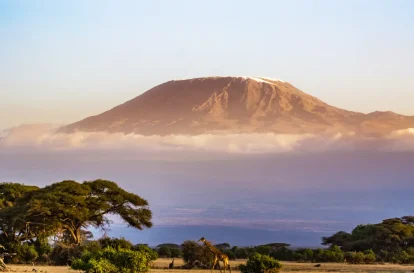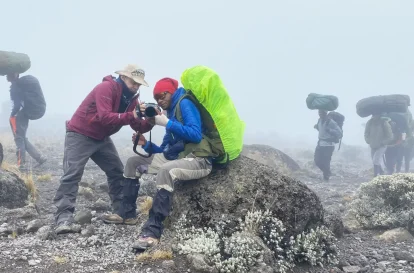Mount Kilimanjaro Climbing Guide
UPDATED IN 2025
- Kilimanjaro Climbing Guide
- When is the best time to climb Kilimanjaro
- How much does it cost to climb Kilimanjaro
- How to best prepare physically for your Kilimanjaro climb
- What risks are involved in climbing Kilimanjaro
- What to pack for your Kilimanjaro ascent
- Which route is right for you
- How to book your expedition with us
- More about Travel Insurance
- How can i travel to mount Kilimanjaro
- Best time to visit based on its season
- How many days to summit
Your Essential Guide to Climbing Kilimanjaro
The snows of Kilimanjaro have been tempting adventurous spirits for centuries. Standing proud and glorious above the plains, she invites you to put one foot in front of the other for the ultimate prize – to conquer Africa’s most impressive mountain. There are six main routes that will take you to the top. Each pathway holds its own challenges, its own fortunes, and its own mesmerizing sights. The route you choose will determine what kind of adventure you have.
The crown of Africa boasts a vivid array of landscapes. You will creep beneath the howl of blue monkeys in the rainforest, you will cross wild moorlands pleated with soft heather, you will tiptoe through an alpine desert stripped bare and steeped in the shadow of the summit. Finally, you will stand on the edge of the world as you reach the diamond bright summit.
The day you conquer Kilimanjaro is a day you are sure to remember forever. The day you did something amazing on this glorious place called Earth.
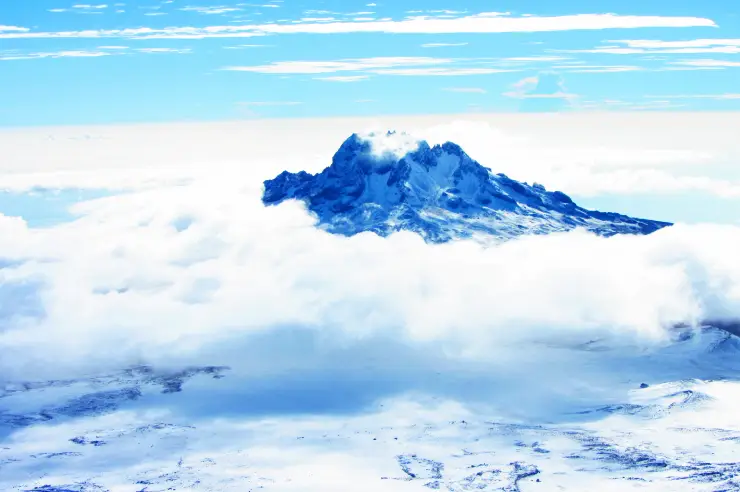
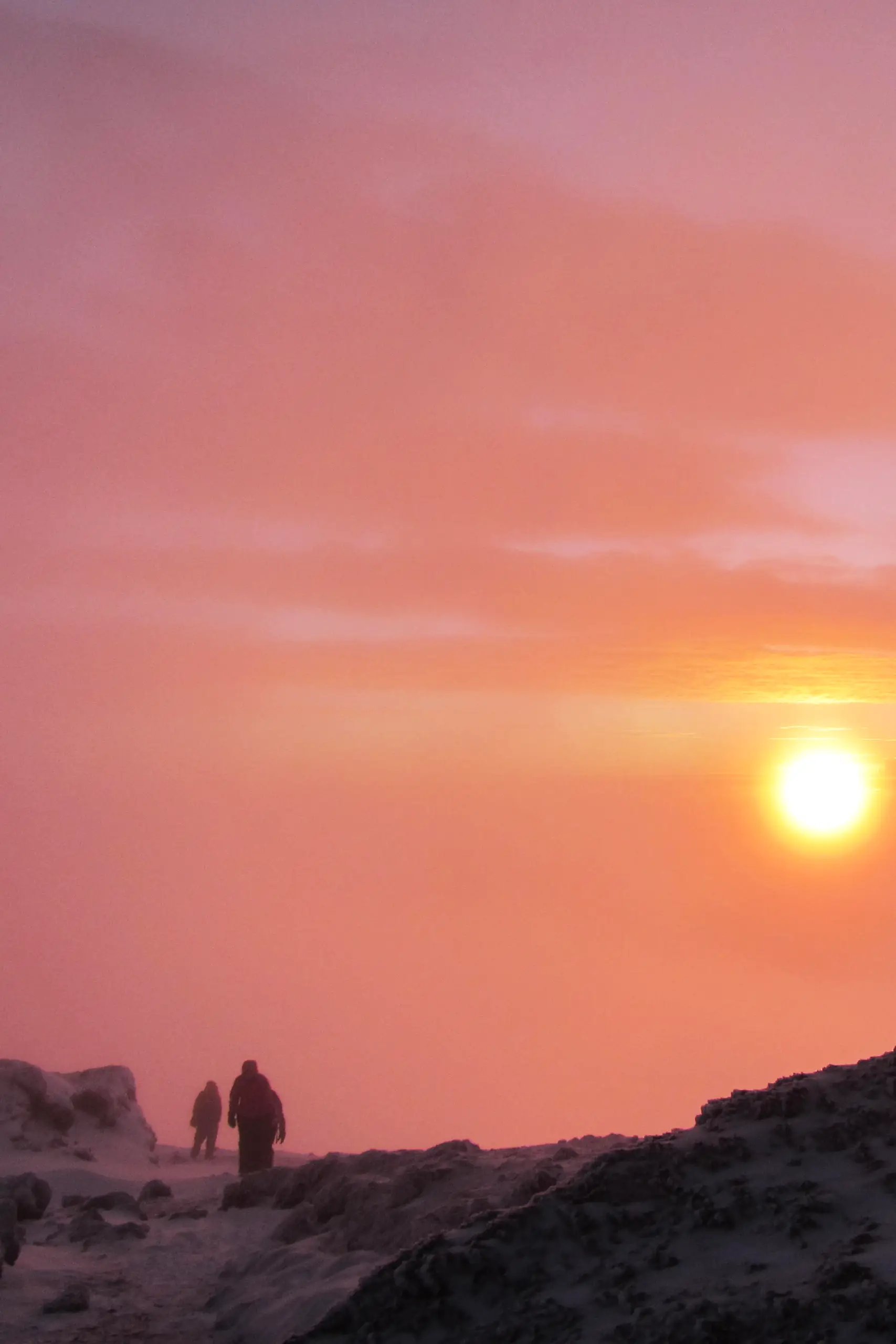
Calculate Your Summit Success Rate
For the best chance of reaching the summit, we strongly recommend a 7-day or longer itinerary on either the Lemosho or Rongai route. A longer climb is crucial because it allows your body to properly adjust to the altitude, which is the most important factor in preventing altitude sickness. The Lemosho and Rongai routes are designed for optimal acclimatization, providing a more gradual ascent. If you’re looking for an alternative, the Machame route is a great third choice.
Kilimanjaro Difficulty: What to Expect on Your Climb.
How Challenging is a Kilimanjaro Ascent? Can a Beginner Succeed?
Reaching the summit of Mount Kilimanjaro is a challenging feat, but it doesn’t require any special technical skills or climbing experience. Even seasoned climbers approach the mountain with a lot of respect, especially during the final 600 meters, which are incredibly tough and demand immense mental strength.
The key to a successful climb is proper acclimatization. A longer itinerary, typically 7 to 8 days, gives your body the time it needs to adjust to the high altitude and dramatically lowers your risk of altitude sickness.
While no outfitter can guarantee a successful summit, choosing a reputable company like Bush to City Adventures gives you the best possible chance. Our experienced guides know how to support you, helping you leverage your strengths and get through the difficult moments, maximizing your opportunity to reach the top.
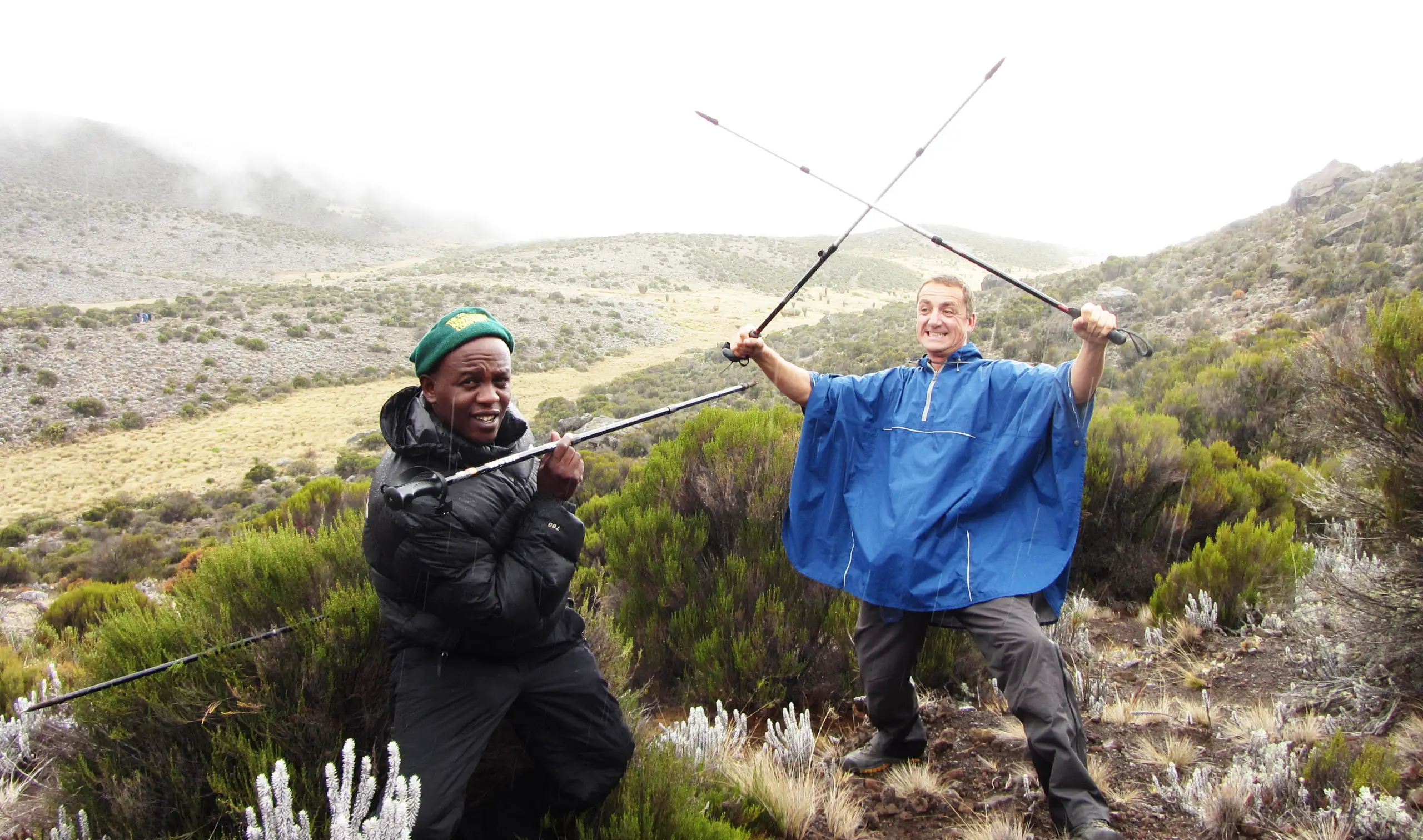
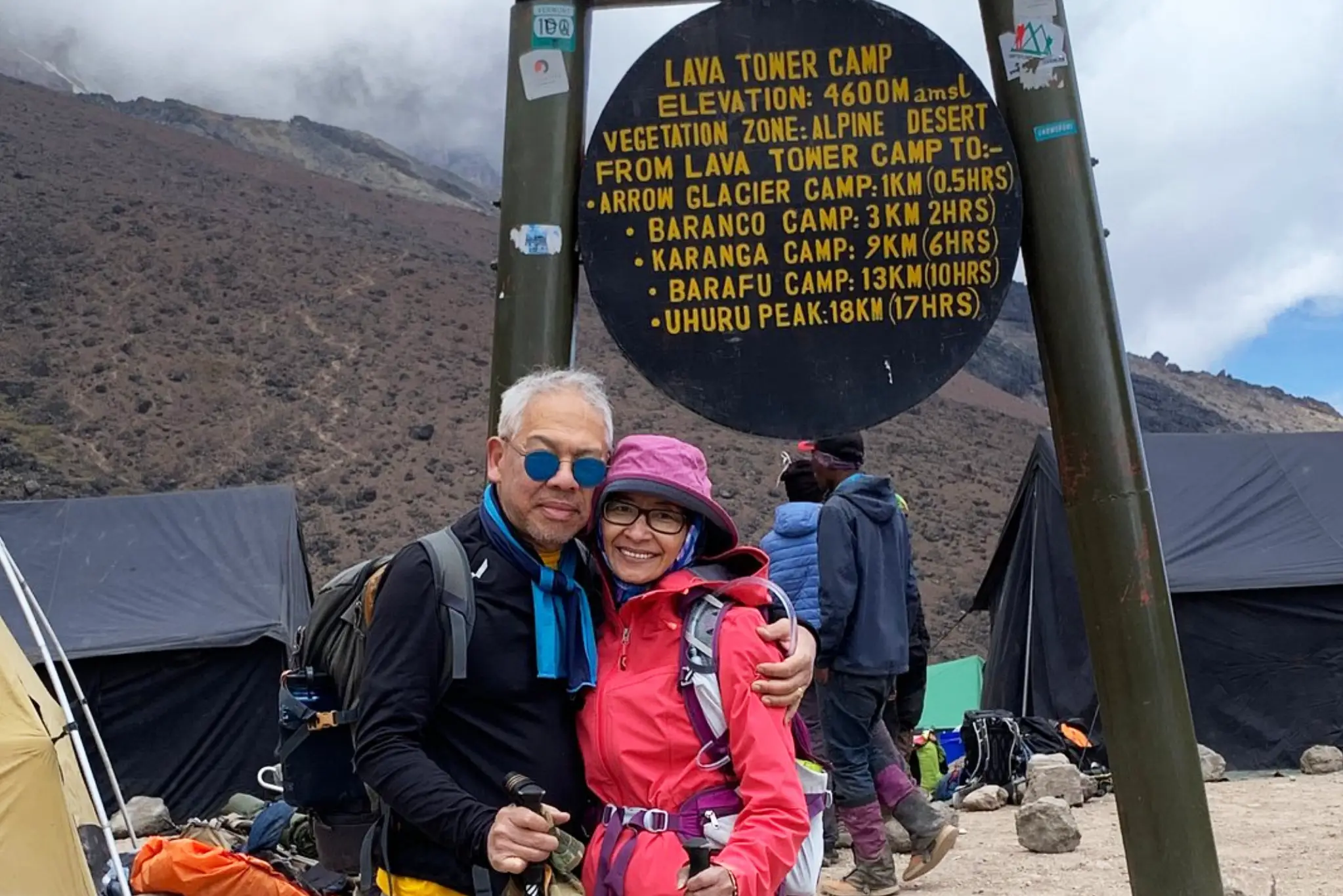
Kilimanjaro Itinerary
Planning a Kilimanjaro ascent? Bush to City Adventures offers flexible packages to suit your interests:
12-Day Package: This beginner-friendly option includes a seven-day climb up Mount Kilimanjaro, followed by a two-day safari in the stunning Tarangire and Ngorongoro National Parks.
13/14-Day Package: For an extended safari experience, this package also features a seven-day Kilimanjaro climb, with a post-expedition four-day safari in the iconic Serengeti National Park and Ngorongoro Crater.
Both comprehensive itineraries are designed to help you experience all of Tanzania’s top attractions, including dedicated days for arrival, departure, and rest.
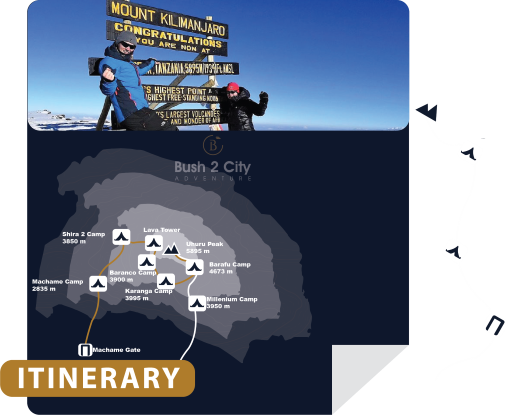
Sample Combined Tour Itinerary
14-Day Peaks, Plains & Beach
Kilimanjaro, Serengeti & Zanzibar
Facts to know before your Kilimanjaro hike
HIGHEST POINT
UHURU PEAK
5,895 M / 19,341 FT
FAMOUS FOR
THE HIGHEST
THE HIGHEST
THE HIGHEST
FAMOUS FOR
SEVEN SUMMITS
THE HIGHEST
5-9 days
Kilimanjaro Hike Durations
$3,500
Average Climb Cost
95%
Summit Success Rate
Your Kilimanjaro Pre-Climb Checklist: Everything You Need to Know
When is the best time to climb Kilimanjaro
The optimal times to climb Kilimanjaro are generally from late December to early March and mid-June to late October, when the weather conditions are most favorable. While other months do experience rain, it typically occurs later in the day, leaving significant periods of clear weather for trekking. It’s also common to have days without any rainfall even during these wetter seasons.
Our Awards and Certifications





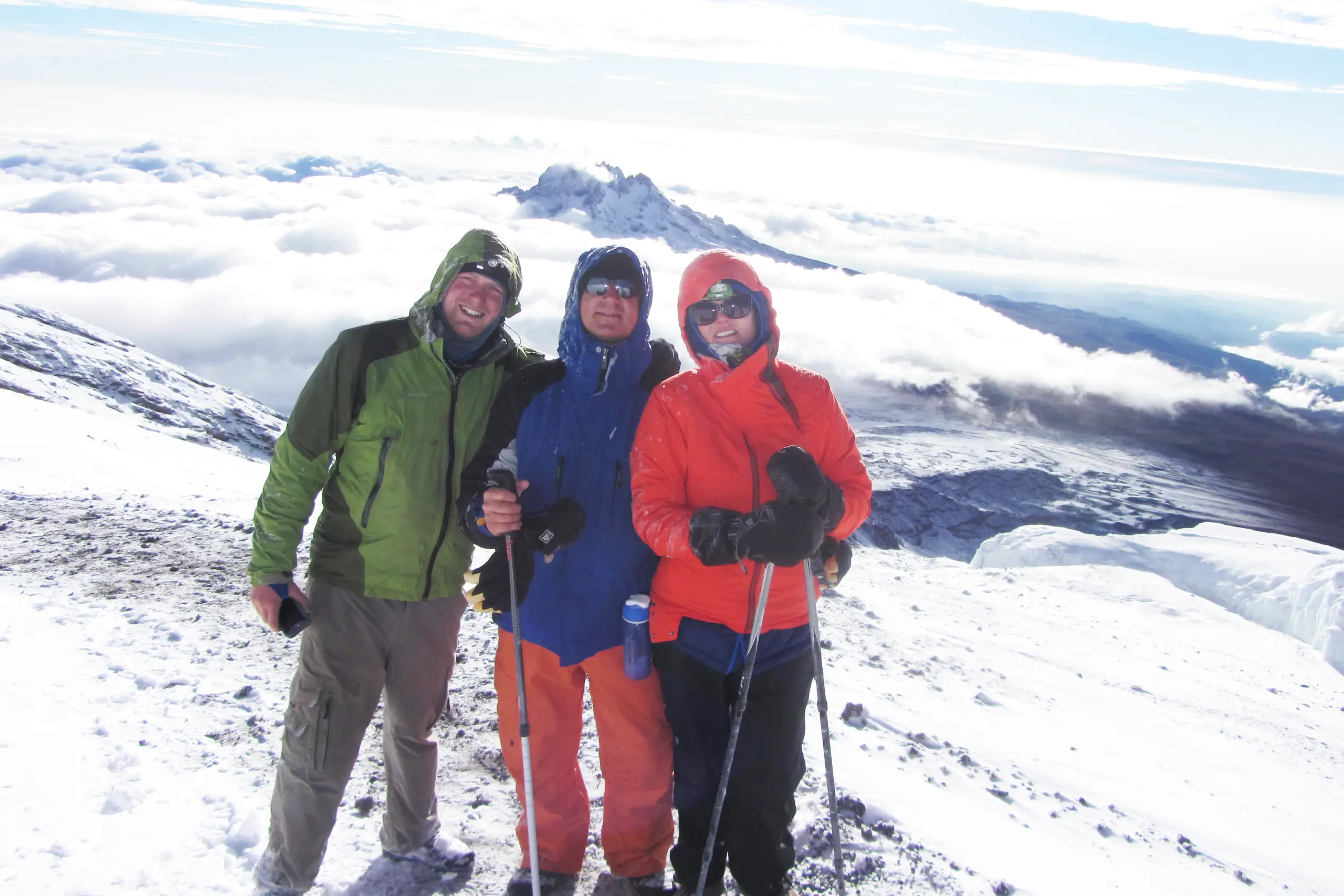
Climbers After Summit Mount Kilimanjaro
How much does it cost to climb Kilimanjaro
As of 2025, a standard 7-day group climb with Bush to City Adventures is priced at approximately $2400. Shorter 5-6 day adventures or trips with seasonal discounts may range from $2200-$2700. This cost incorporates national park fees, which constitute about 40% of the total expedition expense. We advise caution against offers significantly below this price, as exceptionally low rates can often indicate inadequate porter welfare, including underpayment and insufficient provisions, which compromises both their safety and that of the climbers.
Experience Kilimanjaro's Epic Moments
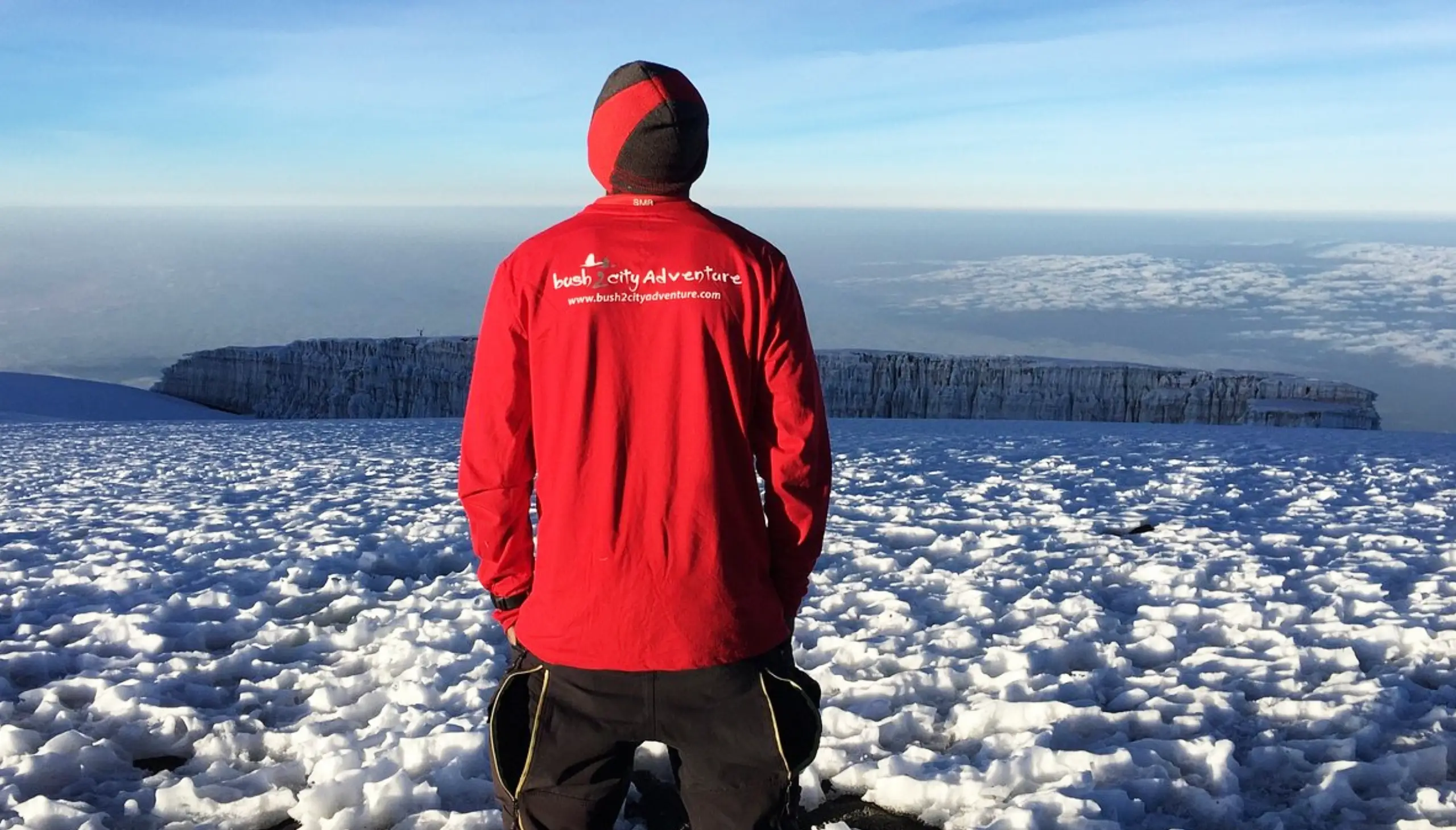
VIDEO COMMING SOON!!
How to best prepare physically for your Kilimanjaro climb
A moderate level of fitness is crucial for a comfortable and successful Kilimanjaro climb. This generally means being able to run 5 km (3 mi) and hike 10 km (6+ mi) in a day without significant difficulty. Effective training should focus on building cardiovascular endurance and leg strength. Recommended activities include swimming, cycling, running, and hiking, particularly on varied terrain or with inclines, to best simulate the conditions on the mountain.
What risks are involved in climbing Kilimanjaro
The primary risk associated with climbing Kilimanjaro is Acute Mountain Sickness (AMS), which results from insufficient acclimatization. In severe instances, AMS can progress to life-threatening conditions such as cerebral or pulmonary edema, contributing to approximately ten fatalities on the mountain annually.
Fortunately, AMS is largely preventable. To mitigate this risk, Bush to City Adventures strongly recommends choosing a seven-day or longer itinerary to allow for proper altitude adaptation. Staying well-hydrated and maintaining a slow, steady pace during your ascent are also crucial for effective acclimatization. Furthermore, the expertise of your guides is paramount. Ensure you select an operator whose Kilimanjaro guides are certified Wilderness First Responders, trained to effectively manage emergencies and facilitate necessary evacuations.
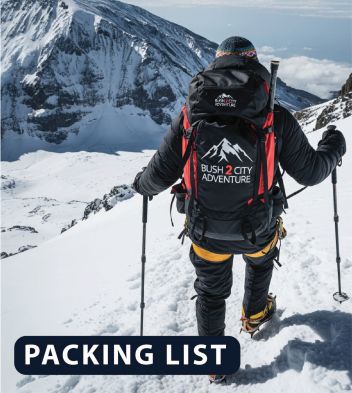
Kilimanjaro Packing List
What to pack for your Kilimanjaro ascent
Navigating Kilimanjaro’s Diverse Climates
A Kilimanjaro trek is an extraordinary journey through five distinct climatic zones, transitioning from lush tropical forests at the base to harsh Arctic conditions near the summit. Temperatures can vary dramatically, ranging from a brisk −15∘C (5∘F) at night on the summit to a warm (68∘F) at the mountain’s base.
Given Kilimanjaro’s unpredictable weather where sunshine can rapidly give way to rain or strong winds and then clear again proper preparation is essential. To ensure a safe and comfortable trek, you’ll need the right clothing, footwear, a suitable sleeping bag, trekking poles, and other essential gear.
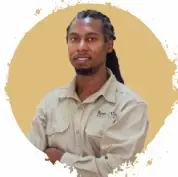
Jackson Solomon
Insider's Take
Do not underestimate the serious altitude of Kilimanjaro (5,895m/19,341ft). Poor acclimatization is the leading cause of high-altitude sickness, which can unfortunately lead to tragic outcomes. Bush to City Adventures emphasizes that choosing a reputable operator is crucial. Many low-cost alternatives use substandard equipment and employ unqualified guides lacking essential first aid and emergency management skills, significantly increasing risks to climber safety.
Which route is right for you
Selecting the optimal Kilimanjaro route hinges on individual priorities such as summit success rates, scenic preferences, and desired crowd levels. For detailed information on specific Kilimanjaro routes, please click here.
The Machame Route, often called the ‘Whiskey Route,’ is a highly popular choice due to its scenic diversity, taking trekkers through varied landscapes from lush rainforests to stark alpine deserts. It offers both 6- and 7-day itinerary options.
Pros:
Highly scenic with diverse landscapes.
Excellent acclimatization profile on the longer, 7-day itinerary
Cons:
Can become crowded during peak seasons.
The 6-day option provides less time for acclimatization, making it less recommended for beginners.
The Machame trail begins in the tropical rainforest on Kilimanjaro’s southern slope. Bush to City Adventures strongly advises beginners to select the seven-day option for improved acclimatization. Many of Bush to City Adventures’ group climbs utilize the Machame Route.
The Lemosho Route is a popular choice for Kilimanjaro, known for its beautiful scenery and excellent acclimatization. It typically runs for 7 or 8 days.
Pros:
• Stunning Scenery: Diverse landscapes and fantastic views, especially on the western side.
• Great Acclimatization: The longer itinerary (especially 8-day) significantly boosts summit success rates.
• Less Crowded Start: Enjoy a more solitary experience in the early days.
Cons:
• Longer & Costlier: Requires more time and can be more expensive.
• Later Crowding: Merges with Machame, so later stages can get busy
Lemosho starts on the western side in rainforest. Many operators, including Bush to City Adventures, recommend the 8-day option for better acclimatization and a more enjoyable trek, especially for first-timers.
The Marangu Route, or ‘Coca-Cola Route,’ is Kilimanjaro’s oldest path, unique for its hut accommodation instead of camping. It’s typically 5 or 6 days.
Pros:
• Hut Accommodation: Sleep in shared huts, not tents, offering basic shelter
• Initially Gradual: Often considered an easier initial ascent.
• More Budget-Friendly: Can be a cheaper option.
Cons:
• Lower Success Rate (especially 5-day): Very poor acclimatization on the shorter option.
• Less Scenic Variety: Same path up and down, offering less diverse views.
• Can Be Crowded: Very popular, leading to busy trails and huts.
Marangu starts on Kilimanjaro’s southeast. Bush to City Adventures recommends the 6-day option for better acclimatization, as the 5-day version has a notoriously low success rate.
The Rongai Route approaches Kilimanjaro from the north, near the Kenyan border, offering a unique and generally less crowded experience. It’s often chosen for its drier conditions and is usually a 6 or 7-day trek
Pros:
• Less Crowded: Especially in the early days, you’ll encounter fewer trekkers.
• Drier Conditions: Being on the northern side, it receives less rainfall, which can be ideal during the wet seasons.
• Gentle Ascent Profile: The initial slopes are more gradual, which can aid acclimatization.
Cons:
• Logistically Remote: Longer drive to the trailhead.
• Merges Later: Joins the more popular Marangu route for the descent, so it can get busier towards the end
• Camping Only: No huts, meaning you’ll be sleeping in tents throughout the climb.
The Rongai trail starts in a more remote, dry wilderness. For better acclimatization and higher success rates, Bush to City Adventures recommends the 7-day Rongai option. It’s a great choice if you prefer solitude and drier conditions, especially during the wetter months.
The Umbwe Route is Kilimanjaro’s most challenging and direct path, known for its steep ascent and minimal acclimatization opportunities. It’s typically a 5 or 6-day trek.
Pros:
• Highly Scenic: Offers dramatic views, especially in the early stages and near Barranco Wall
• Least Crowded: Its difficulty means fewer trekkers, providing a solitary experience.
• Ultimate Challenge: Ideal for highly experienced and very fit hikers seeking a demanding climb.
Cons:
• Very Steep and Direct: Rapid altitude gain makes acclimatization extremely difficult.
• Low Success Rate: Due to the fast ascent, it has one of the lowest summit success rates.
• Not for Beginners: Strongly advised only for seasoned trekkers with excellent physical and mental endurance, often with prior high-altitude experience.
The Umbwe route starts on Kilimanjaro’s southern side in the rainforest. Bush to City Adventures, like most reputable operators, does not recommend the Umbwe Route for beginners due to its inherent challenges and low success rates. It’s best suited for those looking for a true test of their mountaineering capabilities.
The Northern Circuit is Kilimanjaro’s newest and longest route, offering a full circumnavigation of the mountain and exceptional views. Typically 8 or 9 days.
Pros:
• Highest Success Rate: Longest route with excellent acclimatization, leading to the highest summit success rates.
• Stunning & Diverse Scenery: Offers 360-degree views and varied landscapes as it circles the mountain.
• Least Crowded: Especially on the northern side, providing a more remote and peaceful experience.
Cons:
• Longest & Most Expensive: Requires more time and is generally the priciest option.
• Camping Only: No huts; trekkers sleep in tents throughout the climb.
Starting on the western side, the Northern Circuit largely follows the Lemosho route initially before veering north. Bush to City Adventures highly recommends the Northern Circuit, especially the 9-day option, for trekkers seeking the best possible acclimatization, a comprehensive experience of Kilimanjaro’s diverse beauty, and a quieter trek.
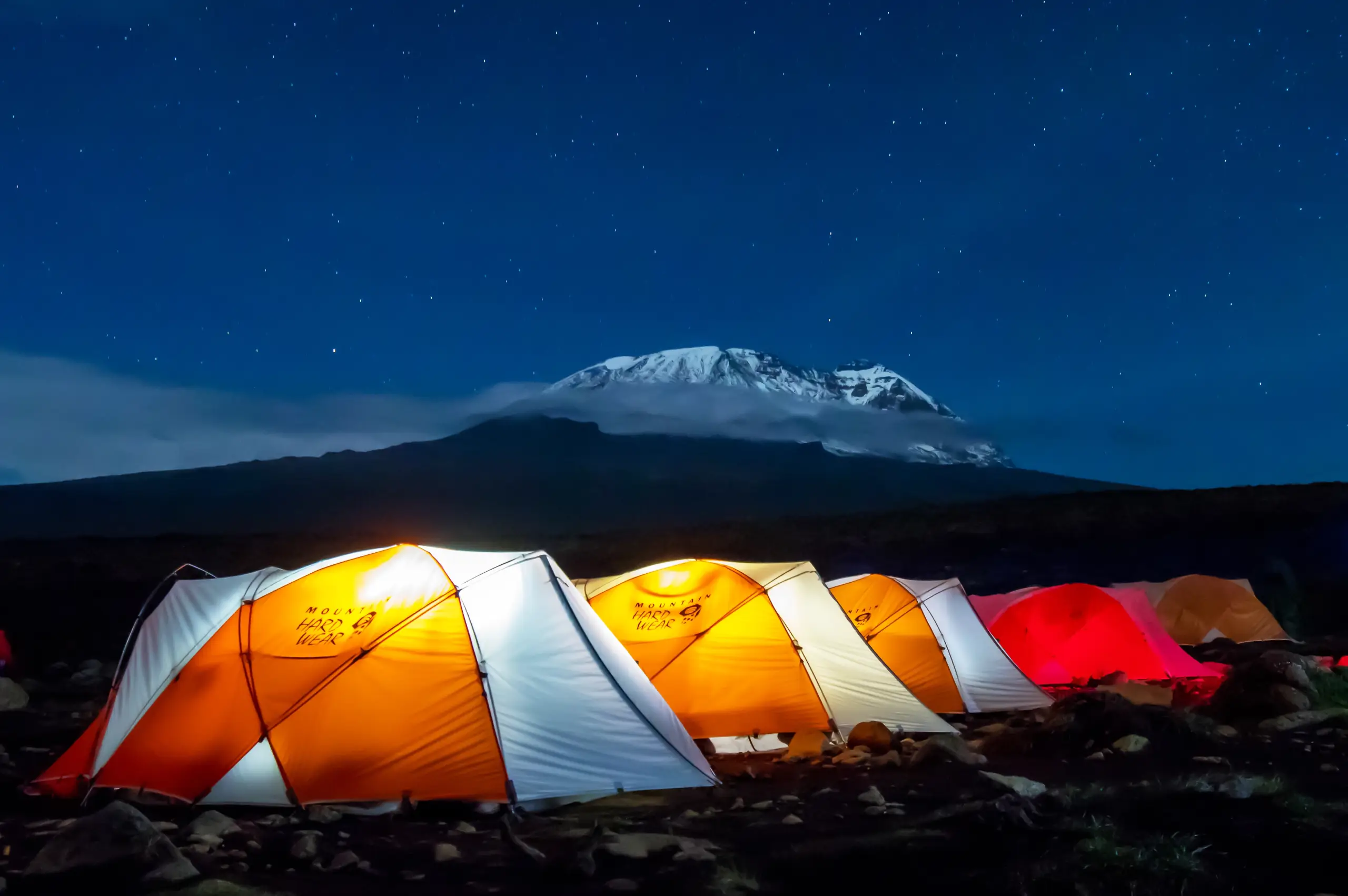
Machame Route
For a truly unforgettable and highly successful journey up Mount Kilimanjaro, our Machame Route treks provide exceptional acclimatization across their 6 or 7-day itineraries. This route unveils incredible scenery as you ascend from Machame Gate, journeying through diverse ecological zones. You’ll experience an authentic tented camp adventure each night, with convenient private transfers to and from the trailhead handled for you.
Lemosho Route
The Lemosho Route is a fantastic choice for climbing Kilimanjaro, praised for its incredible scenery and how well it helps climbers acclimatize. Starting on the west side, it guides you through diverse landscapes, including lush rainforests where you might spot wildlife, all while offering stunning views. Its longer, 7-to-8-day duration is key, providing ample time to adjust to the altitude, significantly boosting your summit chances. Plus, it typically starts with fewer crowds, offering a more peaceful experience before joining a more popular route for the final ascent.
Marangu Route
The Marangu Route uses huts for accommodation.
For the best chance of success, choose the 6-day option (60-70%+ summit rate) for better acclimatization. The 5-day option has a much lower success rate (under 50%) due to insufficient time to adjust to the altitude.
It’s generally less steep and comfortable but also the most crowded route.
Rongai Route
The Rongai Route starts near the Kenyan border on Kilimanjaro’s northeast side, offering views of the Amboseli plains. You’ll climb past Mawenzi Peak to reach the summit.
We’ll take you to Rongai Gate to begin your ascent. You’ll go along the crater rim via Gillman’s Point to Uhuru Peak. The descent is via the more active Marangu Route, where you’ll sleep in tents.
We highly recommend the 7-day option for good acclimatization and to enjoy the beautiful views.
Umbwe Route
The Umbwe Route offers an unparalleled challenge on Mount Kilimanjaro, renowned as the most direct and rugged path to its summit. This formidable ascent is specifically designed for highly experienced and exceptionally fit trekkers who seek a less-trafficked and profoundly demanding adventure. Despite its challenges, the Umbwe Route promises breathtaking views and an unparalleled sense of accomplishment for those prepared to take on its formidable ascent.
Northern Circuit Route
The Northern Circuit is the longest Kilimanjaro route, known for great acclimatization, amazing views, and high summit success.
Its 8-9 days allow better altitude adjustment and offer 360-degree scenery. It’s also less crowded.
However, it’s longer, more expensive, and requires good stamina.
Perfect for those wanting the best summit chance, a quieter trip, and willing to spend more time and money.
Kilimanjaro groups to join in 2025-2026
Read our review of group Kilimanjaro climbs to learn how they’re different from private treks.
Bush to City Adventures offers two excellent options for your Kilimanjaro ascent:
Private Climbs: Ideal for those seeking a fully customized experience, a private climb means it’s just you, your family, or friends, accompanied by our expert team. You set the schedule, pace, and tailor the itinerary precisely to your needs, prioritizing privacy and flexibility.
Open-Group Climbs: Join fellow adventurers from around the world on an open-group climb. These expeditions foster great camaraderie and team spirit, offering a fantastic opportunity to connect with like-minded travelers. You’ll still enjoy the same top-level service and safety standards as our private climbs
How to book your expedition with us
To ensure a smooth booking process with Bush2City Adventures, here are a few key details about our booking terms and conditions. For a complete overview of all our policies, please click here

Gladness
- BASED IN TANZANIA
Dreaming of the summit? Your Kilimanjaro Climb Starts Here
Need assistance? We’re here to help.
FAQs About Kilimanjaro Climbing
More about Travel Insurance
When considering travel insurance for your Kilimanjaro climb, Bush to City Adventures recommends Global Rescue or World Nomad due to their reliable services. Your policy should specifically include three crucial components:
• High-altitude trekking coverage up to 6,000 meters.
• Helicopter evacuation in case of emergencies.
• Comprehensive medical services.
How can i travel to mount Kilimanjaro
The most convenient way to reach Mount Kilimanjaro is by flying into Kilimanjaro International Airport (JRO) in Tanzania. From JRO, it’s approximately a 50-minute drive to Moshi, the town where most climbs commence. For additional information on traveling to Tanzania, please refer to our detailed guide.
Best time to visit based on its season
Tanzania experiences two distinct rainy seasons and two dry seasons annually. The short rainy season typically runs from early November to late December, followed by a dry season lasting until mid-March. The long rainy season then commences, concluding in mid-June.
For Kilimanjaro climbs during a rainy season, Bush to City Adventures recommends considering routes on the northern slopes. Data from the Tanzania Meteorological Authority indicates these areas receive significantly less rainfall—up to five times less. Suitable Kilimanjaro routes for these periods include Rongai, Northern Circuit, and Marangu.
How many days to summit
While a Kilimanjaro ascent can be completed in a minimum of 5 days, Bush to City Adventures advises that most expeditions span 6 to 8 days. This extended itinerary significantly enhances acclimatization, which is crucial for increasing your chances of reaching the summit. For those seeking a more comprehensive experience, extended routes, including options with an overnight stay in the crater, can last 10 days or even longer.
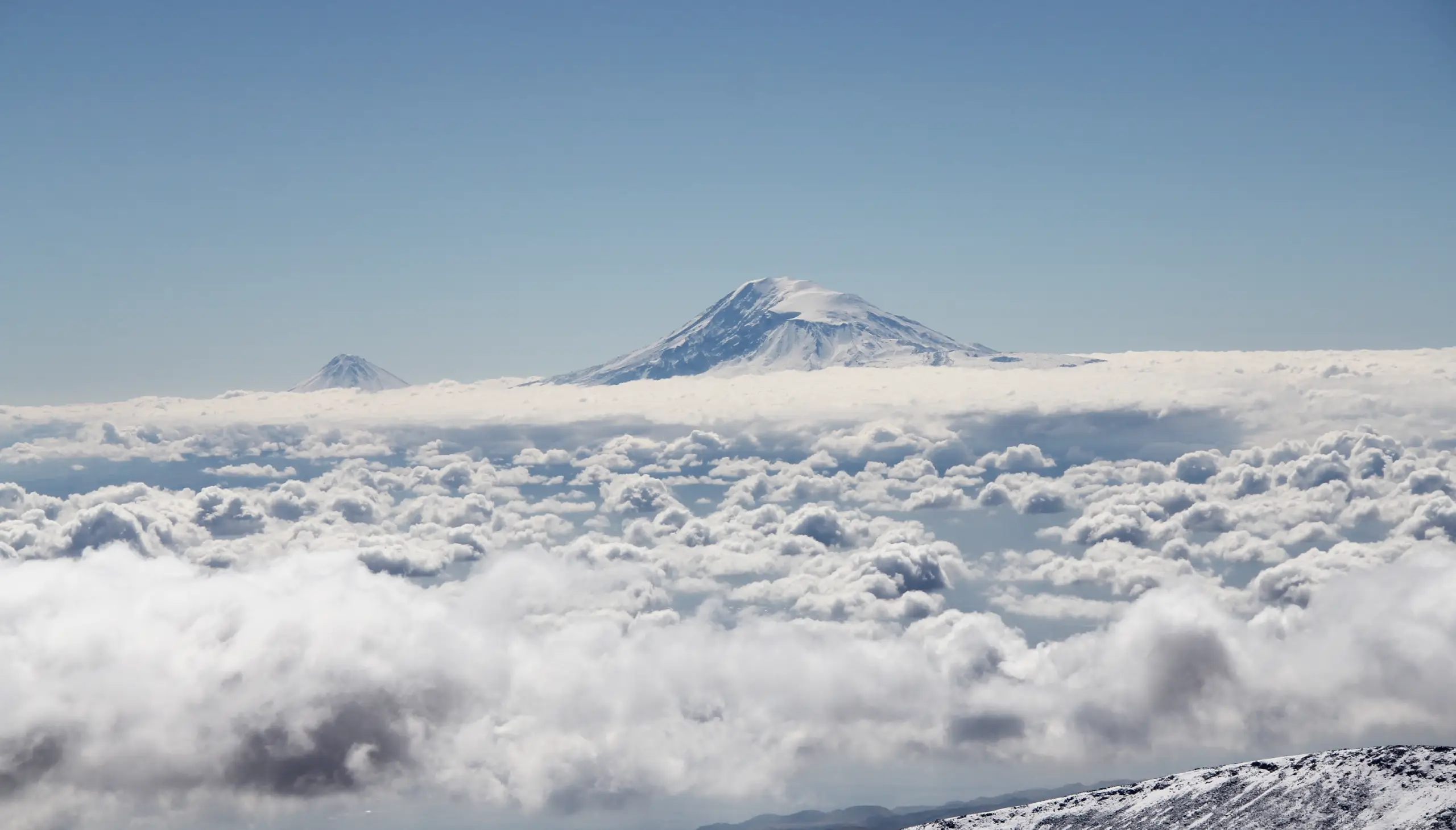
EXCELLENTVerified Trip of a Lifetime Our fabulous “trip of a lifetime” proved to be everything we envisioned. Animals roaming free on the African landscape; a balloon ride over the Serengeti; spectacular sunsets; amazing tented outposts within the National Parks.The people were warm, welcoming and ensured our every comfort.With special thanks to our guides and driver, Nickson, who took very good care of us.This was truly a spectacular experience!Posted onVerified Amazing company This was our second Safari. The company did an amazing job with all the planning, selection of hotels, guides and vehicles. Jackson organized our trip and he did an amazing job. Our guides were David in Tanzania and Richard in Kenya. They went above and beyond the call of duty. We use this company because a friend of ours from Switzerland had used them and had an amazing experience with them as well. I highly recommend them.Posted onVerified Best trip ever We booked this 13 days best of Kenya and Tanzania luxury tour with Jackson, the owner of the company. It was privet tour. He answerd all our questions. Added one extra day in Nairobi. Everything was very organized .And the nice touch to the trip was that Jackson meet with us in the middle of the tour.The guides- drivers Patrik and Ali are the best! They are very knowledgeable and experienced guides and great people. The best! They new where to go to find animals. And we saw all of them!All the lodges and camps were excellent. All of them were inside the parks. It's very important not to waist time,while you'd like to see animals. It was amazing to see animals and birds walking on camp or lidge territory, you can here at night elephants or lions make noise.The food was delicious! Mostly it was buffet. If you need to take lunch box , chef would come to your tabe and ask what to cook for you (at camps).The most important part of the trip are people . They are so nice! I'd like to say special thanks to people from. Sametu camp. Ian, Alex and everyone else made out stay feel like being at home with my friends. Thanks to everyone for making our trip unforgettable!Posted onVerified Kenya and Tanzania Safari We had a fantastic Safari with Bush2city across Kenya and Tanzania. Our guides John and Ali had outstanding experience and extremely knowledgeable and the accommodation was first class. We can highly recommend Bush2city for your safari!!Posted onVerified Life changing experience This was a life changing adventure, from the start with Jackson answering a million questions to the end seeing the big 5- but what was most special was our guide - ally -he made us feel at home, safe and comfortable- his knowledge of the area is incredible driving ability outstanding and his personality infectious. If a safari is on your list please take my advice and book with bush 2 cityPosted onVerified Better than I imagined! Mali @ Bush2city tailored our trip to maximize the variety of safari experiences while considering our requests & preferences. She was also responsive to our inquiries/requests during our trip. When a camp was closed due to flooding, she provided alternate options.All of our accommodations & hosts were great or exceptional. Our safari guide Steve for 3 days in Kenya was knowledgeable, patient regarding our questions, fun-loving, & determined to provide a full safari experience.Ally, our guide in Tanzania for 10 days, was knowledgeable about game animals, other desert animals & birds. Not only did he locate animals prior to other guides (frequently alerting other guides), but many times he spotted animals & waited, anticipating their behavior. Therefore, we saw several animal crossings, hunting, training offspring, & 2 male elephants fighting. He was fun-loving, patient with us, & filled-in when a subcontractor needed assistance.I always felt safe with our guides driving & the lodge environments. All the people worked tirelessly to provide a welcoming & memorable experience.Posted onVerified Absolutely fantastic!!! Our trip with Bush2City was amazing! Mali from the company took care of everything for us...arranging wonderful hotels and camps! If any issue arose, she was right there to help! Our guides, Steve and Ally were amazing and made it even a better experience! They both were very attentive to all our needs and made sure we were safe and comfortable. Both were extremely knowledgeable, kind, friendly, helpful and had a wealth of knowledge! They made sure we saw the big five as well as so much more! Absolutely incredible and I could not say enough good things about them both! Our favorite camp was in the Central Serengeti, Sametu. The food and staff were amazing ( shout out to Ramadhan and the xhef). Accommodations were wonderful and the property was magical. From start to finish everything was wonderful. All the camps had their own unique charms and everywhere the staff was amazing! Thank you to all who made our trip/experience absolutely wonderful!!! A trip of memories that will last a lifetime!!!Posted onVerified Absolutely fabulous The trip was absolutely fabulous and Mali from Bush2City was wonderful to work with! She took care of everything for us and would quickly respond to all of our questions and needs. Our guides, Steve and Ally, were incredible and we feel so fortunate to have had them both!!! We already miss them! Our favorite camp was Sametu where Ramadhan took incredible care of us! The food was superb and the accommodations outstanding! We enjoyed wonderful drinks with an amazing sunset there. My one complaint, would have liked to stay there for another day or two to actually enjoy the property.Huge thank you to Mali, Steve, Ally, Ramadhan and all the others that had any part in our incredible adventure!Oh, and we saw plenty of the big 5 as well as every other animal we expected and didn't expect to see!Thank you all for an incredible trip!Posted onVerified Bush2city is amazing!! I highly recommend We did a 6 days luxury safari covering terengire, lake manyara, serengeti, and ngorongoro crater. We went as a family of four, with two kids aged 6 and 8. It was our and our kids favorite vacation of all time. Everything was exquisitely organized by Maliwaza, including a birthday surprise cake for my youngest. Our guide Hussein was the best. He went above and beyond to seek out animals we wanted to see. He arranged each day based on our interest, preferred schedule, and energy levels. We were able to see the big five and many many more, thanks to him. The hotels camps chosen were better than I ever expected, in location, comfort and luxury. I highly recommend this company and especially Hussein.Posted onVerified Ally is the goat Absolutely amazing vacation! Ally is hands down the best driver and guide you could ask for. His knowledge of the area and instincts for finding wildlife are truly unmatched—he knew exactly where to go and when, and thanks to him, we saw way more animals and incredible sights than anyone else we talked to on other tours. Every stop felt intentional and special, and it was clear that Ally genuinely loves what he does. If you're booking a safari, do yourself a favor and ask for Ally
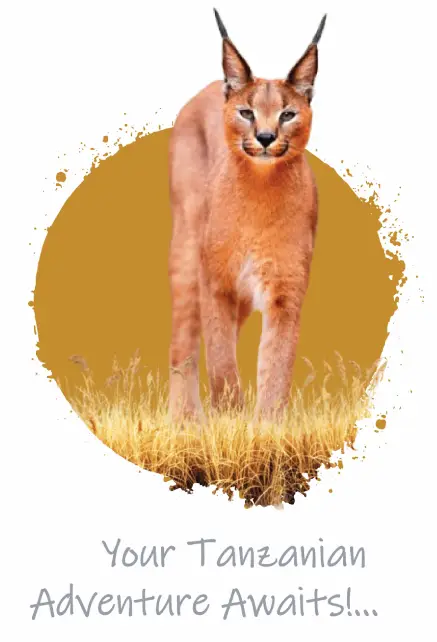
Request a program

Ready to plan your next adventure?
Tell us your ideas, and we’ll craft a personalized travel itinerary within 3 hours.


